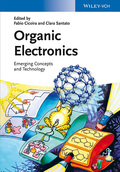Organic Electronics
Emerging Concepts and Technologies

1. Edition September 2013
464 Pages, Hardcover
150 Pictures
Monograph
Short Description
Cover Figure: Used with kind permission of Matitaccia.
Focusing on the tremendous potential of organic electronics, this book covers such emerging topics as organic spintronics, iontronics, organic metamaterials, which are most likely to gain momentum over the next decade.
Buy now
Price: 125,00 €
Price incl. VAT, excl. Shipping
Euro prices for Wiley-VCH and Ernst & Sohn titles are only valid for Germany. In EU countries, local VAT applies. Postage will be charged.
- Out of print -
An overview of the tremendous potential of organic electronics, concentrating on those emerging topics and technologies that will form the focus of research over the next five to ten years.
The young and energetic team of editors with an excellent research track record has brought together internationally renowned authors to review up-and-coming topics, some for the first time, such as organic spintronics, iontronics, light emitting transistors, organic sensors and advanced structural analysis.
As a result, this book serves the needs of experienced researchers in organic electronics, graduate students and post-doctoral researchers, as well as scientists active in closely related fields, including organic chemical synthesis, thin film growth and biomaterials.
Neural cells on conducting polymer surfaces.
Transmission Electron Microscopy studies of organic semiconductor films.
New electron acceptors in organic photovoltaic cells.
Light Emitting Field Effect Transistors.
Melanin films for organic bioelectronics.
Organic spintronics.
Photophysical and photoconductive properties of novel organic semiconductors and their composites.
Single crystal organic field effect transistors.
Neutral Cluster Beam Deposition of Organic thin films.
Organic sensors.
Printed organic electronics and bioelectronics.
Soft lithography and soft contact lamination for plastic electronics.
Organic Nanoparticles.
Hybrid light-emitting electrochemical cells.
Unraveling molecule-film-device `extended? correlations.
Organic electrochemical transistors in sensing and bioelectronics.
Organic devices for low-cost, large-area electronics.
Clara Santato (PhD in Chemistry) is, since August 2007, Assistant Professor at the Department of Engineering Physics of Ecole Polytechnique in Montreal (EPM). Before her appointment as Assistant Professor, she worked as Permanent Research Scientist for the National Research Council of Italy. She has been visiting scientist at the National Renewable Energy Laboratory and at Purdue University. Her background is in: Organic Electronics: she pioneered the design, fabrication, and optoelectronic characterization of Organic Light Emitting Field Effect Transistors; Materials Science: she synthesized and characterized nanostructured materials for applications in photoelectrochemical solar energy conversion by scanning probe microscopy, Raman micro-spectroscopy, and grazing incidence x-ray diffraction.


